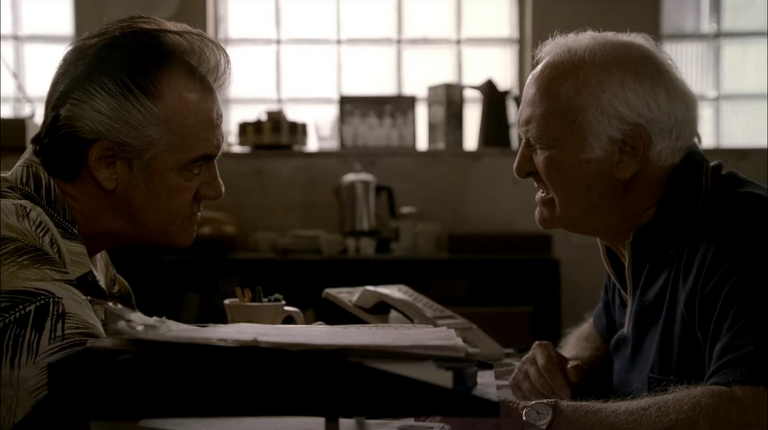Television Review: Where's Johnny? (The Sopranos, S5X03, 2004)

Where’s Johnny? (S05E03)
Airdate: March 21st 2004
Written by: Michael Calleo
Directed by: John Patterson
Running Time: 54 minutes
The fifth season of The Sopranos opens with the assured quality that cemented the show’s legacy, deftly balancing existential angst with the brutal rhythms of mob life. Yet while the premiere episodes re-establish the series’ gripping tension, the third instalment, Where’s Johnny?, feels comparatively subdued. Though competently crafted, its lack of high-stakes drama renders it less impactful within a season otherwise marked by escalating familial and organisational fractures. This is not to dismiss the episode’s merits—its exploration of dementia’s ravages and the futility of control remains poignant—but it lacks the narrative urgency that defines the show’s most memorable hours.
The episode’s title, a nod to Tony’s deceased father Johnny Soprano, crystallises the tragic core of Uncle Junior’s storyline. Having previously hinted at Corrado’s cognitive decline, the episode strips away ambiguity: Junior, now lost in delusions, flees his home in search of his long-dead brother. His pitiful odyssey—ending with police intervention—serves as a grim affirmation of his dementia. Parallel to this, Janice’s spiral into cruelty towards Bobby’s children underscores the Soprano family’s generational cycles of dysfunction. When Tony, initially hostile towards Junior, realises the old man’s aggression stems from illness, his fury pivots to Janice, culminating in a visceral brawl. Bobby’s subsequent dilemma—choosing loyalty between his mercurial wife and his mob boss—adds layers to his character, painting him as a man increasingly alienated from both domestic stability and the machismo of street life.
Junior’s incapacity subtly destabilises Tony’s grip on the DiMeo family, coinciding with external threats from the Lupertazzi civil war. The power struggle between Little Carmine’s reluctant leadership and Johnny Sack’s naked ambition manifests in chilling scenes of coercion. Tony’s proposed triumvirate—a nod to Roman history—aims to broker peace by enlisting retired underboss Angelo Garepe (played by Joe Santos). Yet the plan collapses under Sack’s hubris and Angelo’s contentment in semi-retirement, highlighting the futility of applying classical logic to modern gangland chaos.
In a lesser but revealing subplot, Feech La Manna’s return to crime ignites a turf war over landscaping territories—a darkly absurd microcosm of the mob’s petty avarice. His savage beating of Sal Vitro (played by Luigi Mustillo), a meek landscaper, exemplifies Feech’s anachronistic ruthlessness. Paulie’s retaliation—thrashing Feech’s cousins—exposes the fragile loyalties underpinning these conflicts. Tony’s “compromise”, forcing Sal to forfeit half his business and work gratis for the Sopranos, underscores the show’s cynical worldview: violence begets violence, and the powerless (here, Sal) always pay the steepest price.
Notably, Where’s Johnny? is the sole episode excluding Carmela Soprano—a bold choice by writer Michael Imperioli (credited under pseudonym Michael Calleo). Rather than contriving a subplot to showcase Edie Falco’s formidable talent, the script prioritises narrative economy. This restraint reflects the show’s maturity, refusing to indulge fan service in favour of thematic cohesion.
The episode’s most provocative turn involves Lorraine Calluzo, introduced earlier as a formidable mafiosa. Here, she is grotesquely humiliated—offering sexual service in exchange for her life—a far cry from the “strong female character” archetype modern audiences might expect. This degradation, though jarring, critiques the romanticisation of mob glamour, reminding viewers that in this world, power is fleeting and brutality indiscriminate. Lorraine’s downfall refuses to sanitise the mafia’s misogyny, offering a grim counterpoint to contemporary media’s often-sanitised “girlboss” narratives.
Where’s Johnny? may lack the visceral thrills of The Sopranos’ finest hours, but its psychological acuity and thematic richness merit attention. Through Junior’s tragedy, the Lupertazzi power struggles, and Lorraine’s humiliation, the episode dissects the erosion of identity and authority in a world devoid of honour. Its quieter moments—Tony’s reluctant empathy for Junior, Sal Vitro’s resigned defeat—linger precisely because they reject easy resolutions. In a series famed for its moral complexity, this instalment reaffirms that decay, both mental and moral, is the only true constant.
RATING: 6/10 (++)
Blog in Croatian https://draxblog.com
Blog in English https://draxreview.wordpress.com/
InLeo blog https://inleo.io/@drax.leo
InLeo: https://inleo.io/signup?referral=drax.leo
Hiveonboard: https://hiveonboard.com?ref=drax
Rising Star game: https://www.risingstargame.com?referrer=drax
1Inch: https://1inch.exchange/#/r/0x83823d8CCB74F828148258BB4457642124b1328e
BTC donations: 1EWxiMiP6iiG9rger3NuUSd6HByaxQWafG
ETH donations: 0xB305F144323b99e6f8b1d66f5D7DE78B498C32A7
BCH donations: qpvxw0jax79lhmvlgcldkzpqanf03r9cjv8y6gtmk9
Posted Using INLEO